
 Motor Vehicle Brake Energy Conservation System
Motor Vehicle Brake Energy Conservation System
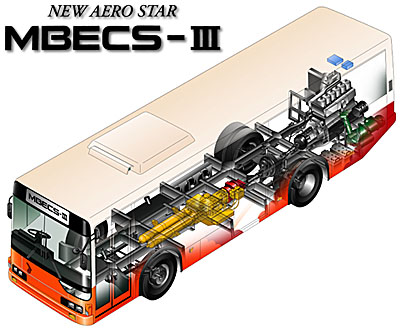
Mitsubishi Motors Corp. earned widespread plaudits for its innovative MBECS-II, a revolutionary diesel/accumulator hybrid system that completely met long-term regulatory targets for slashing exhaust gas production in its vehicles. On October 19, 1996, Mitsubishi Motors launched an advanced version, the MBECS-III, in a bid to create a people-friendly bus for the 21st century. Incorporated in the new model of the New Aerostar, a large commuter bus, MBECS-III represents a quantum leap in environment-friendliness, safety, economy and comfort. Sales began at the end of 1996 in Japan.MBECS: Motor vehicle Brake Energy Conservation System
 System Summary
System SummaryMBECS-III is formed centering on a brake energy conservation system and an oxidation catalyst and idling stop and start system. MBECS-III aims to drastically reduce nitrous oxide, particulates(substance of particles) and the emission of black smoke; and attain a further improvement in mileage.
 Brake Energy Conservation System
Brake Energy Conservation SystemIn conventional vehicles, kinetic energy which had developed was transformed into frictional energy during braking and emitted into the air. This system materializes energy conservation and a reduction in emissions gas by efficiently accumulating energy emitted into the air and reusing such as an energy source when starting the vehicle.
 Idling Stop & Start System
Idling Stop & Start SystemUntil now, 5-10% of the fuel used by city busses on their routes was used while the engine was idling during stops.
MBECS-III enables a further conservation of energy by including a function which automatically stops the engine while the bus is stopped and thus restrains the wasteful consumption of fuel while stopped.
 Oxidation catalyst
Oxidation catalystThe regeneration of the brake energy results in the reduction of the engine load and thus use of an oxidation catalyst, which had been said to be impossible during high load, becomes possible. This results in a large reduction of particulates.
 MBECS-III includes several conventional improvements
MBECS-III includes several conventional improvementsThe capacity of the hydraulic pump/motor was increased and the pump/motor clutch was enhanced to deliver further reductions in fuel consumption, improved internal noise reduction and simpler maintenance. Mitsubishi Motors also improved the design of system components such as the differential and hydraulic fluid tank to enable a low one-step vehicle structure to be incorporated into the cabin floor.
 Effects of MBECS-III
Effects of MBECS-III
Reduced gas emission
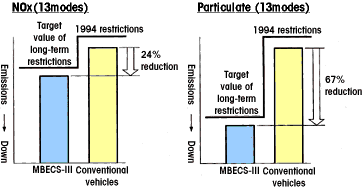
Note: MBECS-III also meets or exceeds other long-term restriction target values for black smoke and other exhaust gas criteria not shown above.
 Practical application
Practical applicationWhile actual fuel consumption varies considerably with driving conditions, in city driving the MBECS-III obtains an average 23% improvement in fuel consumption over conventional vehicles. The greatest improvement in energy conservation is seen in routes with frequent bus stops and no traffic congestion, when the MBECS-III achieves a striking 30% saving in fuel consumption.Black smoke, the worst emissions of which occur at engine start and acceleration, is reduced as much as 50-70% by assisting engine drive with a hydraulic motor.
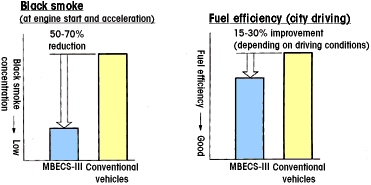
 Overview of New Aerostar incorporating the MBECS-III
Overview of New Aerostar incorporating the MBECS-IIIThe New Aerostar is the world's first hybrid commuter bus to enable inclusion of low-floor one-step construction (550mm from ground to floor at front door).Changes were added to the MP337 (leaf suspension) and MP737 (air suspension) models such as two-step and one-step configuration as well as wheel-base and door position specifications to specify 4 models in a total of 12 types for the New Aerostar (main components such as the engine, transmission, and electronically controlled kneeling system are the same as in existing vehicles).
New one-step setting (first in a hybrid bus)
The New Aerostar lineup includes a one-step type that makes boarding and disembarking easy for everyone from children to seniors.
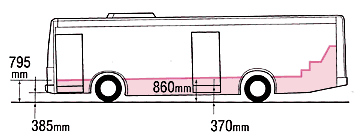
Two-Steps Model
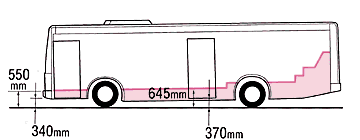
One-Step Model
 Major Specifications (For Japan Models)
Major Specifications (For Japan Models)
| Model Code | KC-MP337K(F) | KC-MP337M(VF) | KC-MP737K(F) | KC-MP737M(VF) | |
|---|---|---|---|---|---|
| Suspension | Leaf suspension | Air suspension | |||
| Step & Door type | Two-steps Front and middle doors | One-step Front and middle doors | Two-steps Front and middle doors | One-step Front and middle doors |
|
| Dimensions (mm) | Overall length | 10,195 | 10,695 | 10,195 | 10,695 | Overall width | 2,490 | Overall height | 3,090 | 3,045 | 3,090 | 3,045 |
| Gross vehicle weight (kg) | 14,360 | 14,520 | 14,410 | 14,670 | |
| Passenger capacity | 73 passengers + 1 crew | 71 passengers + 1 crew | 69 passengers + 1 crew | 69 passengers + 1 crew | |
| Engine | Model code | 6D24 (L6, D1) | Bore x stroke (mm) | 130.0 x 150.0 | Total displacement (cc) | 11,945 | Max. output (JIS) | 240 ps (175kw)/ 2,200 rpm | Max. torque (JIS) | 85 kg-m (835 N-m)/ 1,400 rpm |
| Hydraulic pump / motor | Structure | Inclined plate type axial plunger model | Capacity | 125 cc / rev x 2 (twin) | Operation pressure range | 19.6-34.3MP2 (200-350 kg/cm2) |
| Accumulator | Model | Piston model | |||
| Capacity | 46 litres x 2 | ||||

NEXT TOPIC:"Preparation of the Vehicle Overhaul Manual"
